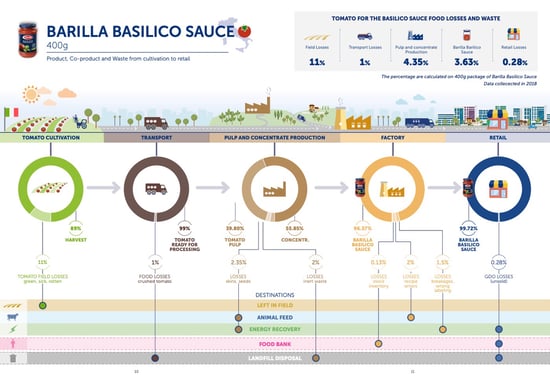How to tackle food waste in 3 steps – part 2

This is a 2-part blog series about food waste, why you should care about it and how to minimize its existence in your supply chain. In the first part we will go through the basics – what is food waste and why does it occur, and more importantly, why companies should commit to reducing it. In part two of this series, we give you hands-on tips on how to work with food waste reduction.
In part 1 we gave a background to where and why food waste occurs is, and the importance of reducing it for compliance. But what other advantages does the reduction of food waste bring? And what can companies do about it?
Some mind-boggling food waste facts...
- 1/3 of all food produced globally is wasted. This amounts to 1.3 billion tonnes of food fit for human consumption being wasted every single year.
- 8-10% of the total Greenhouse gas emissions result from the global food industry
- If food waste was a country, it would be the third largest emitter after the USA and China
- Food waste occurs on every level across the food supply chain, the amount varies depending on the country. In industrialized countries, 40% of food waste occurs at retail and consumption levels alone. In developing nations, 40% of waste occurs in the post-harvest and processing stages, often due to handling, storage, and limited technical capacity.
- Globally, food waste occurs:
32% in farming and production levels
23% in the handling and storage level
10% during processing and packing
13% in distribution and retail
22% in consumption levels
Risk management and the reduction of economic losses
Measuring food waste occurring in the supply chain can help companies identify where the biggest issues lie and implement strategies accordingly. Companies like Barilla, Nestlé, Kellogg, and IKEA are taking lead in the fight against food waste using certain standards, such as the Food Waste and Loss Standard, to measure and report on food waste. Having the correct data can therefore improve the financial performance of companies. Not only through increased resource efficiency, but also by avoiding disposal costs to landfills and waste management.
One of the methods for organizations to reduce food waste is to quantify and measure food waste with the help of questionnaires, according to the Food Waste and Loss protocol guide. Questionnaires are not only a cost & time-efficient way of gathering information but also represent an opportunity to engage and involve respondents and making them more aware of their waste occurring.
Sustainability Management solutions enable organizations to keep track of the food waste recorded from different facilities. Based on the correct data, companies can implement waste reduction activities, with the involvement of all relevant manufacturing locations and facilities.

Supply chain tracking
With knowledge comes power. Measuring data across supply chains enhances the preparedness in case of potential disruptions, mitigates risks, and leads to stronger supplier-buyer relationships. These are robust tactics to reduce food waste occurring in the supply chain, as a better understanding of where and how much food is wasted throughout the supply chain is a crucial starting step to tackle this. Based on that knowledge, sustainable decisions can be taken. With Sustainable Sourcing solutions, data needed for a precise capturing of volumes and possible losses at different stages in the supply chain can be collected. The type of data collected can be aligned with different frameworks, such as the food loss & waste standard to identify food waste and where it occurs in the supply chain.
Increased transparency enables resource efficiency
There is no sustainability without transparency. With growing consumer demands for business transparency, companies taking bold transparency actions are leading the way. Barilla’s Food Loss and Waste Report is an excellent example of how a company can communicate its sustainability measures in reducing food waste through effective measuring and supply chain tracking. Barilla went to the extent of analyzing the entire lifecycle of their Basilico Sauce, visualizing where food waste occurs throughout the supply chain, and its scope in a transparent way. Barilla further shows the efforts it took to reduce food waste, including implementing specific projects, resulting in the saving of 4800 kg of food from going to waste (the equivalent of around 12,000 meals). With the correct measurement, Barilla was able to reach its sustainability goals, and simultaneously communicate this transparently to stakeholders.
 Barilla Food Loss and Waste Report, Barilla Basilico Sauce, Barilla- The Italian Food Company
Barilla Food Loss and Waste Report, Barilla Basilico Sauce, Barilla- The Italian Food Company
With tighter laws and regulations being put in the industry, transparency is now more than ever, becoming a necessity for companies to comply. An understanding of the supply chain using the correct data does not only mitigate risks and reduce food waste, but also allows more resource-efficient food chains, increasing profitability, and allows companies to communicate their commitment to sustainability.
Other ways to reduce food waste for companies in the food industry
- Clear date labeling. Food brands have an important responsibility in educating consumers about food waste, through clearer communication around date-labeling. Big brands like Danone and Arla are for example launching campaigns to raise awareness of the confusion that labeling can bring. For example, by communicating the difference between Use-by & Best-Before.
- Designing innovative circular solutions and putting company strategies to prevent food waste from occurring in the first place.
- Collaboration with actors across the supply chain and turning to food waste initiatives such as Too Good To Go, Karma, and food banks are alternatives in case of ending up with quantities of unsellable stocks.
With Worldfavor, you get all the tools needed to gain oversight of your supply chain. Easily map your supply chain, discover hidden data and risks, and visualize impact by product or category. Our platform will help you increase your sustainability and transparency at every level of your supply chain. Contact us today to get started!
Read part 1 of this two-part blog series on food waste here.Related blogs you might like:






%20as%20the%20deadline%20approaches.%20Learn%20about%20compliance%20requirements%2c%20potential%20delays%2c%20and%20key%20updates..png)

